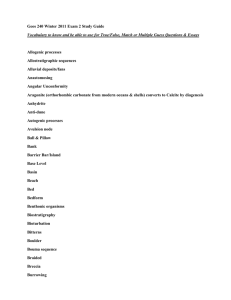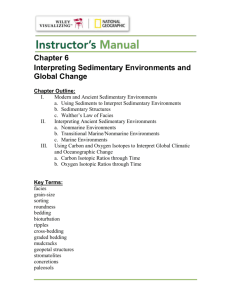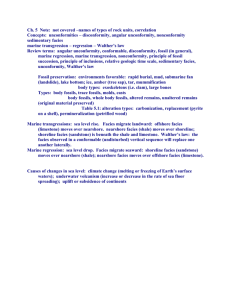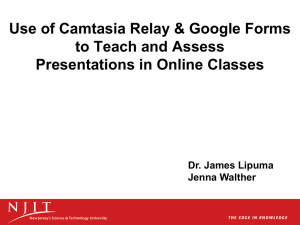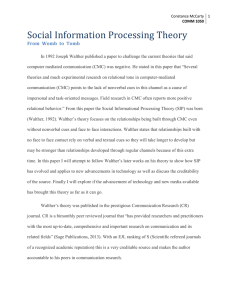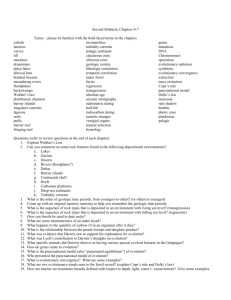GY 402: Sedimentary Petrology UNIVERSITY OF SOUTH ALABAMA Lecture 9: Walther’s Law
advertisement
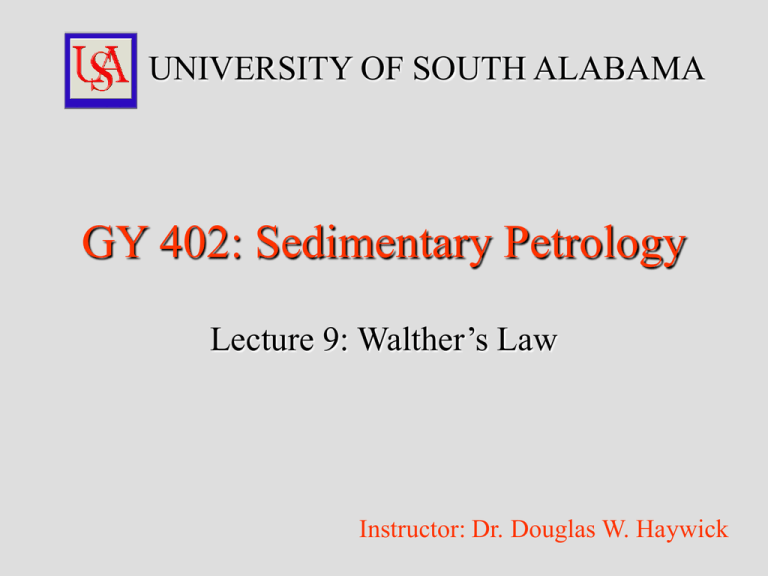
UNIVERSITY OF SOUTH ALABAMA GY 402: Sedimentary Petrology Lecture 9: Walther’s Law Instructor: Dr. Douglas W. Haywick Today’s Agenda 1. Walther’s Law 2. Sequence stratigraphy 3. Markov Chain Analysis Walther’s Law Walther’s Law Named after Johannes Walther (18601937), a German geologist, who in 1894, noted a fundamental relationship between the vertical and lateral distribution of facies. Walther’s Law Sedimentary environments that started out side-by-side will end up overlapping one another over time due to transgressions and regressions. Walther’s Law Sedimentary environments that started out side-by-side will end up overlapping one another over time due to transgressions and regressions. The result is a vertical sequence of beds. The vertical sequence of facies mirrors the original lateral distribution of sedimentary environments. Walther’s Law Sedimentary environments that started out side-by-side will end up overlapping one another over time due to transgressions and regressions. Walther’s Law But… • Walther's Law can only apply to sections without unconformities. Tan and white layers of Mesozoic Era Period Pio Nono Formation in Georgia's Coastal Plain Province. http://itc.gsw.edu/faculty/daskren/fallline.htm Walther’s Law And… • Walther's Law can only apply to a section without subdividing diachronous boundaries [e.g., transgressive surfaces (TS), maximum flooding surfaces (mfs) etc.] Sequence Stratigraphy First utilized by the petroleum industry to interpret depositional surfaces on seismic sections. Now used by all geologists to explain vertical and lateral changes in sediment rock distribution. http://strata.geol.sc.edu/exerices/seismic/07SeqNo_LST_TST_HST.jpg Sequence Stratigraphy First utilized by the petroleum industry to interpret depositional surfaces on seismic sections. Now used by all geologists to explain vertical and lateral changes in sediment rock distribution. http://strata.geol.sc.edu/exerices/seismic/07SeqNo_LST_TST_HST.jpg The 3 controls are: 1) sea level position, 2) sediment input, 3) accommodation space. Sequence Stratigraphy Changes in sea level and sediment supply produce changes in the “stacking of sedimentary packages”. Here sediment supply keeps up with sea level changes Sequence Stratigraphy Here sediment supply exceeds sea level change. Sequence Stratigraphy Here sea level changes exceeds sediment supply. Sequence Stratigraphy Ultimately, sedimentary “packages” are bounded by specific surfaces (reflectors in the seismic lines), and this is where/when Walther’s Law breaks down Walther’s Law But even with these limitations, Walther’s Law offers powerful predictive capabilities, especially for basic facies modeling. Consider the adjacent sequence… Walther’s Law SS: Scoured contact Walther’s Law SS: Scoured contact A: laminated red shale Walther’s Law SS: Scoured contact B: rippled siltstone A: laminated red shale Walther’s Law C: Cross-stratified c-quartz arenite SS: Scoured contact B: rippled siltstone A: laminated red shale Walther’s Law D: Parallel laminated f-quartz arenite C: Cross-stratified c-quartz arenite SS: Scoured contact B: rippled siltstone A: laminated red shale Walther’s Law E: Trough cross bedded vc-quartz arenite D: Parallel laminated f-quartz arenite C: Cross-stratified c-quartz arenite SS: Scoured contact B: rippled siltstone A: laminated red shale Walther’s Law F: massive c-quartz arenite E: Trough cross bedded vc-quartz arenite D: Parallel laminated f-quartz arenite C: Cross-stratified c-quartz arenite SS: Scoured contact B: rippled siltstone A: laminated red shale Walther’s Law G: rippled c to vc-quartz arenite F: massive c-quartz arenite E: Trough cross bedded vc-quartz arenite D: Parallel laminated f-quartz arenite C: Cross-stratified c-quartz arenite SS: Scoured contact B: rippled siltstone A: laminated red shale Walther’s Law Recall that facies repeat in a sedimentary sequence. If you determine the number and variety of transitions, you can start to understand the means by which facies shifted during deposition. Walther’s Law Below are the observed facies transitions for the outcrop(s) in question. The problem is that you really don’t know which are random. All data in these slides from Walker (1979) Walther’s Law Enter statistics (Markov Chain Analysis). Determine the number of transitions from each facies to every other facies and put in a 9 x 9 matrix (one row/column per facies) Walther’s Law SS SS A 2 B 4 B C 12 2 1 6 3 1 2 C D A 2 4 2 G 5 F 1 2 1 G 1 1 2 2 1 F E 1 1 E D 1 1 Determine the number of transitions from each facies to every other facies Walther’s Law SS SS A .154 B .308 B C .800 .133 .067 .462 .231 .077 .286 C D A .154 .571 .667 G 1.00 F .077 .154 .077 G .077 .077 .154 .667 .500 F E .143 .333 E D .500 .333 Then calculate the observed transition probabilities (each row =1.00). Walther’s Law Next calculate transition probabilities for a random sequence Rij = nj N-ni Where Rij is the random probability of transition from facies i to j, ni and nj are the number of occurences of facies i and j and N is the total number of occurrences of all facies Walther’s Law SS SS A B C D E F G .320 .245 .151 .075 .038 .075 .094 .260 .160 .080 .004 .080 .100 .148 .074 .037 .074 .093 .068 .034 .068 .085 .032 .063 .079 .062 .077 A .280 B .259 .315 C .237 .288 .220 D .222 .270 .206 .127 E .215 .262 .200 .123 .062 F .222 .270 .206 .127 .063 .032 G .226 .274 .210 .129 .065 .032 .079 .065 Now it’s a matter of simple math. Observed – random transitions Walther’s Law SS SS A B C D E F G +.48 -.11 -.08 -.08 -.04 -.08 -.09 +.20 +.07 -.08 +.04 -.08 -.02 +.01 +.08 +.04 +.00 +.06 +.08 -.03 -.07 -.09 -.03 +.60 -.08 +.44 -.08 A -.13 B +.05 -.24 C -.24 -0.0 +.35 D +.11 -.27 -.21 -.13 E -.22 -.26 -.20 +.38 -.06 F +.45 -.27 -.20 -.13 -.06 -.03 G +.77 -.27 -.21 -.13 -.06 -.03 +.25 -.07 Positive transitions occur in nature, high positive transitions dominate. Walther’s Law Walther’s Law Upcoming Stuff Homework 1) Midterm exam linked to paper due today 2) Work on your group grain size project due Friday Feb 27th This Week’s Lab Activity 5: Flume exercise Soup Day GY 402: Sedimentary Petrology Lecture 9: Walther’s Law Instructor: Dr. Doug Haywick dhaywick@southalabama.edu This is a free open access lecture, but not for commercial purposes. For personal use only.

